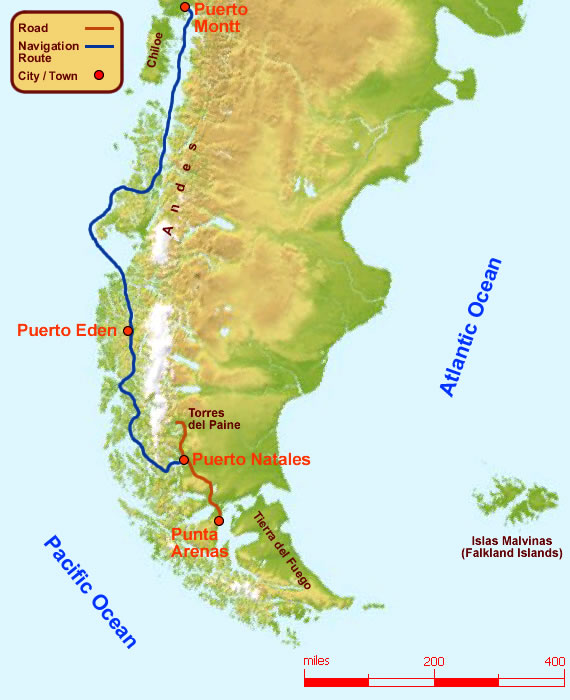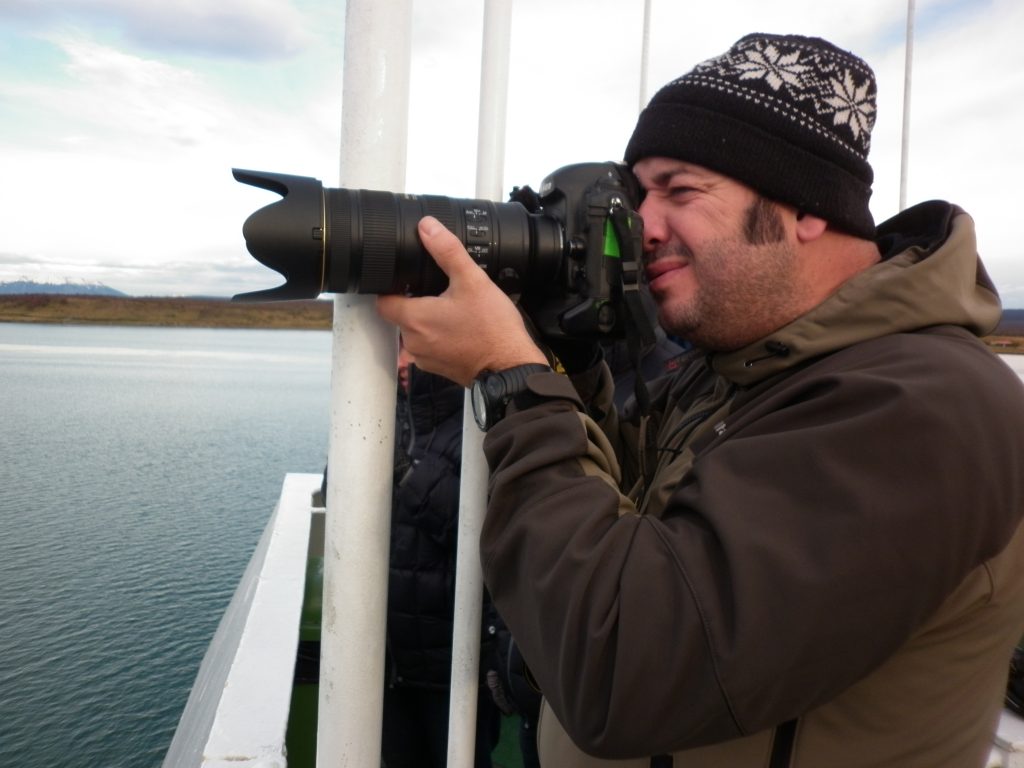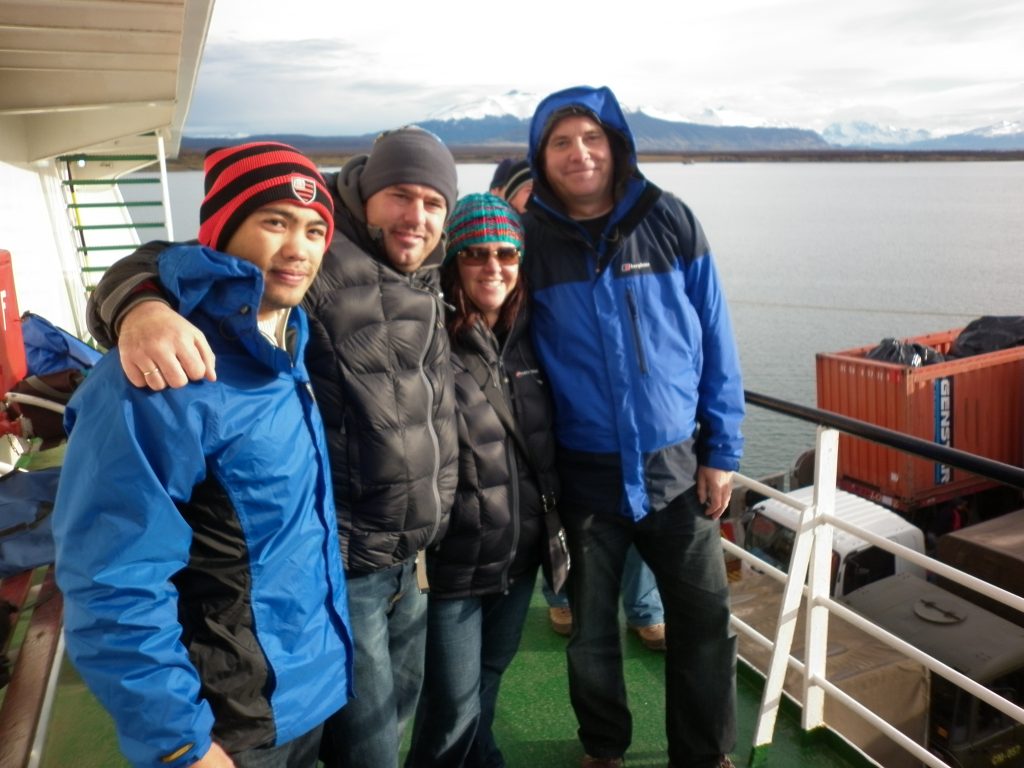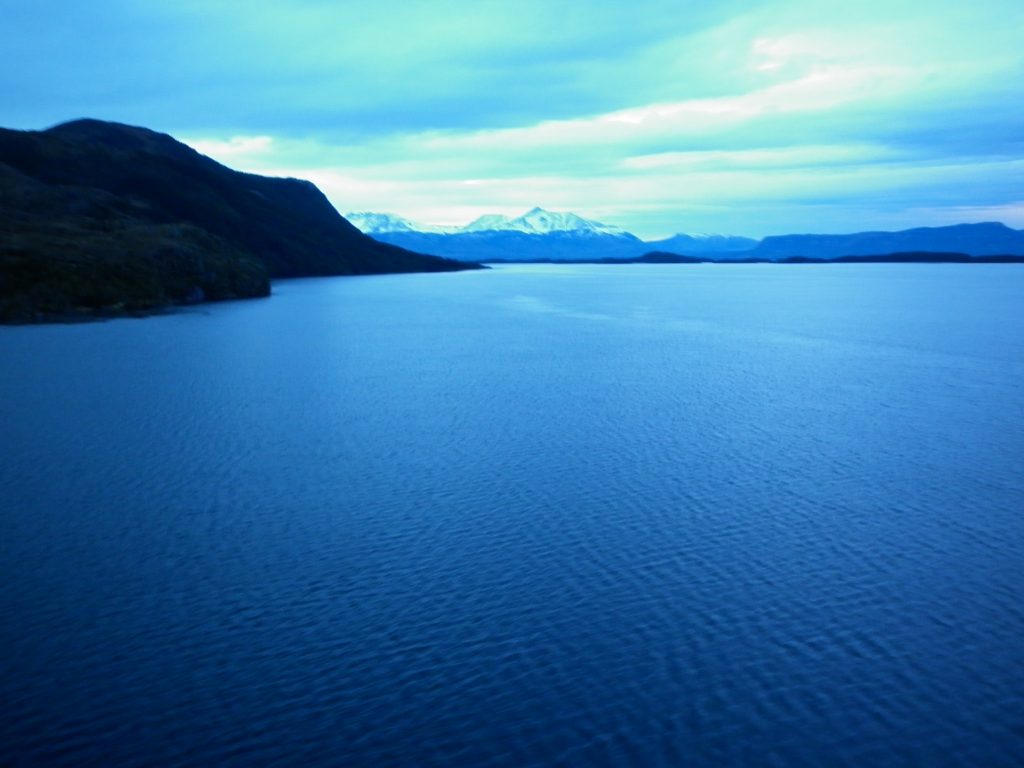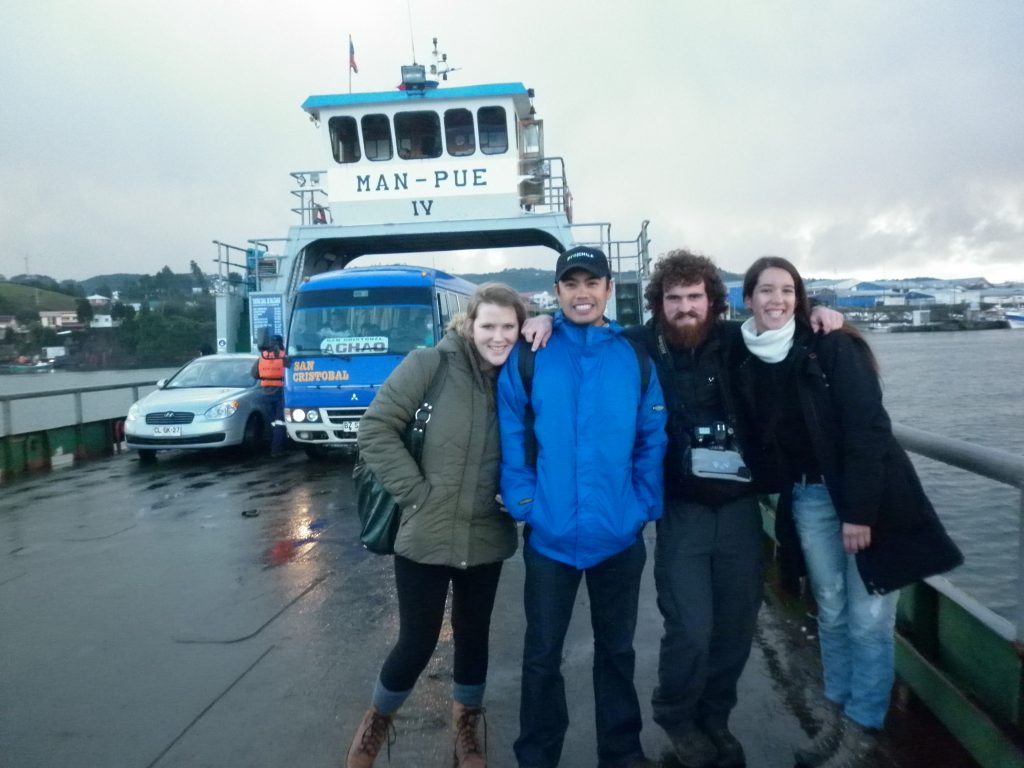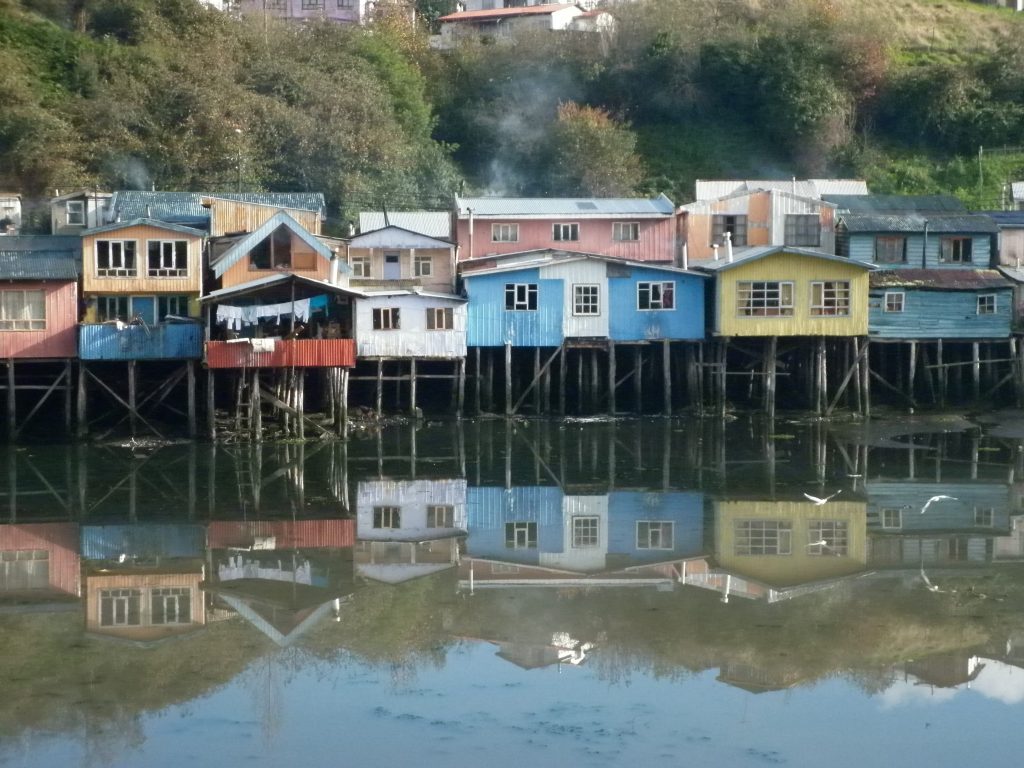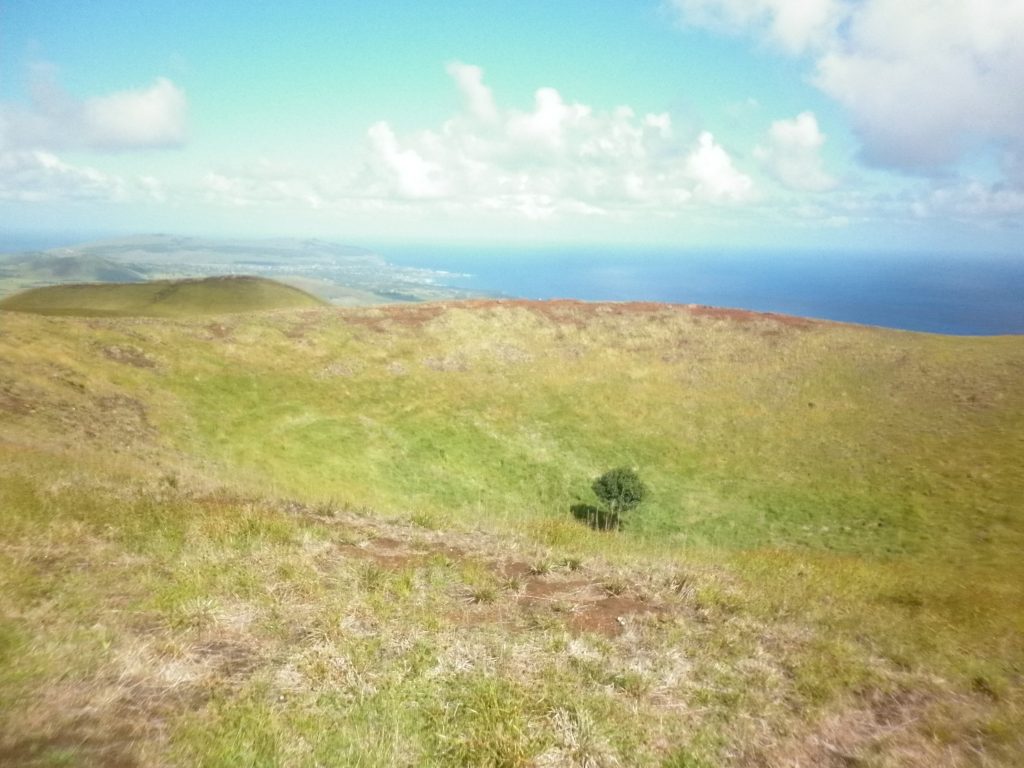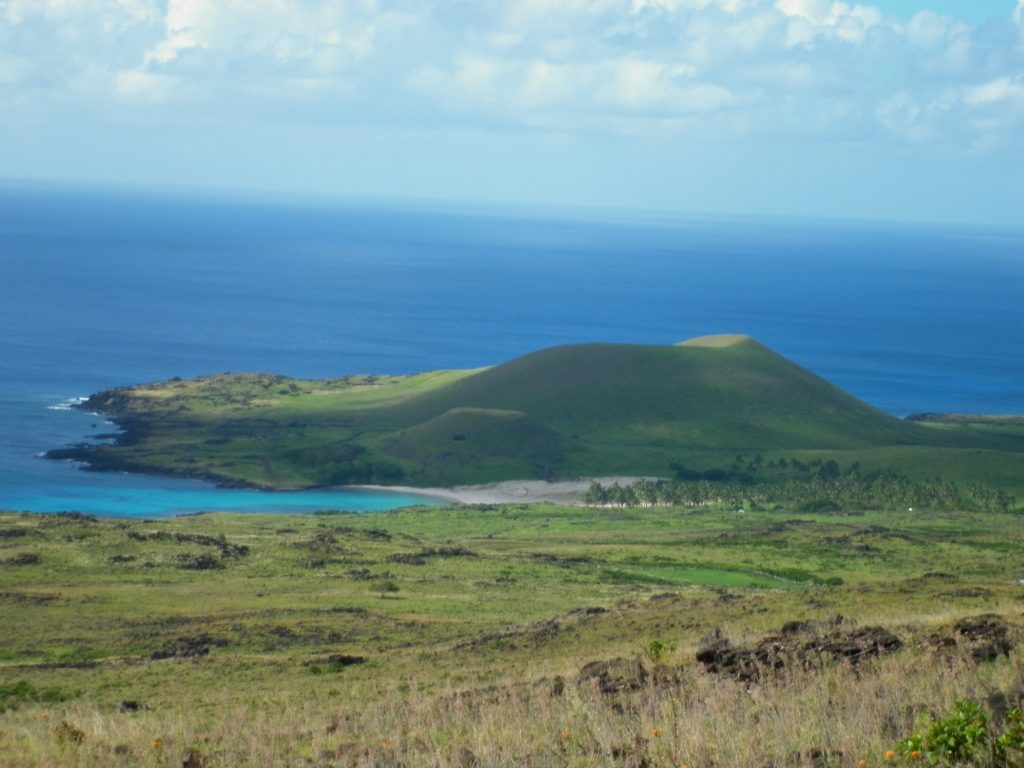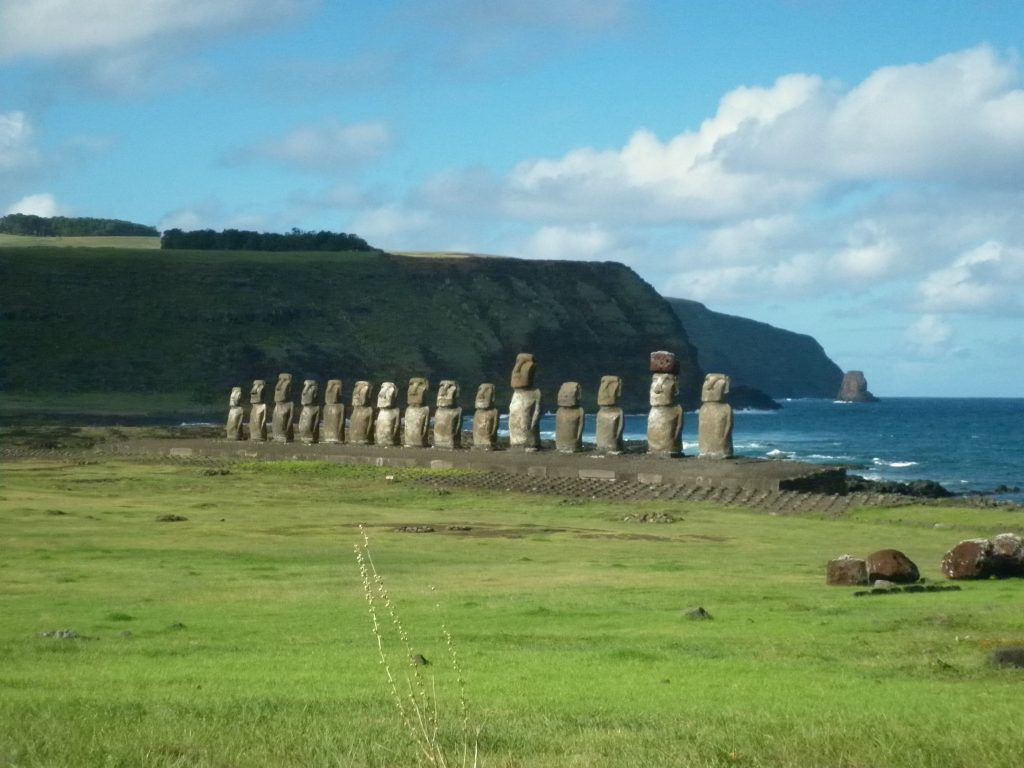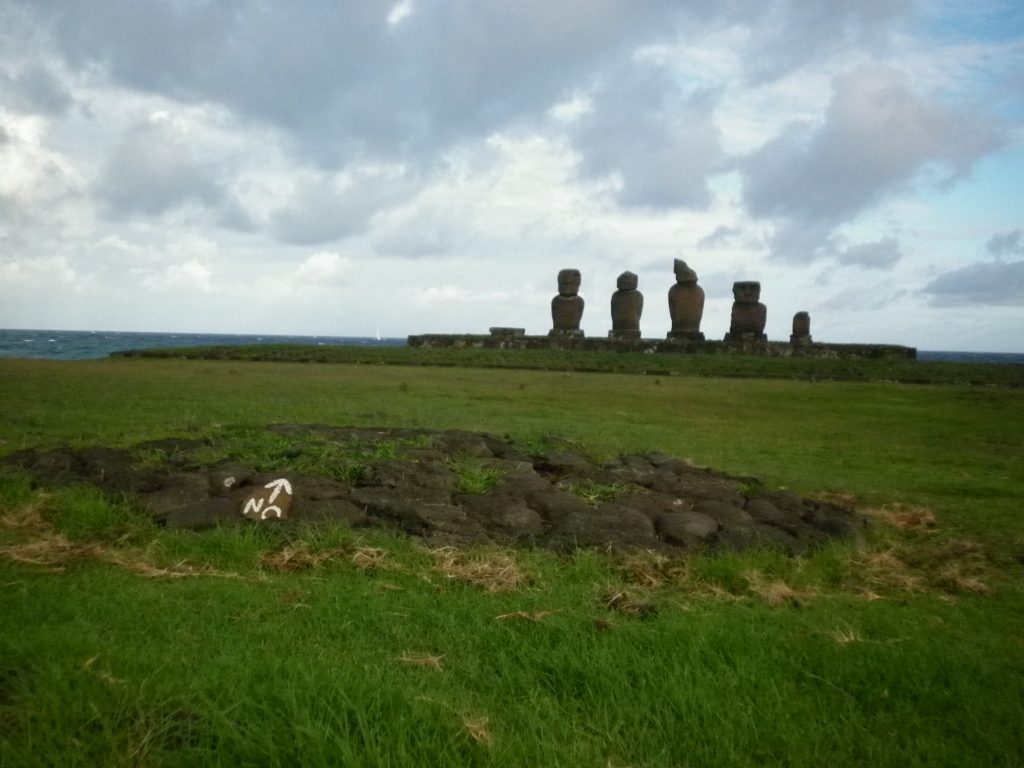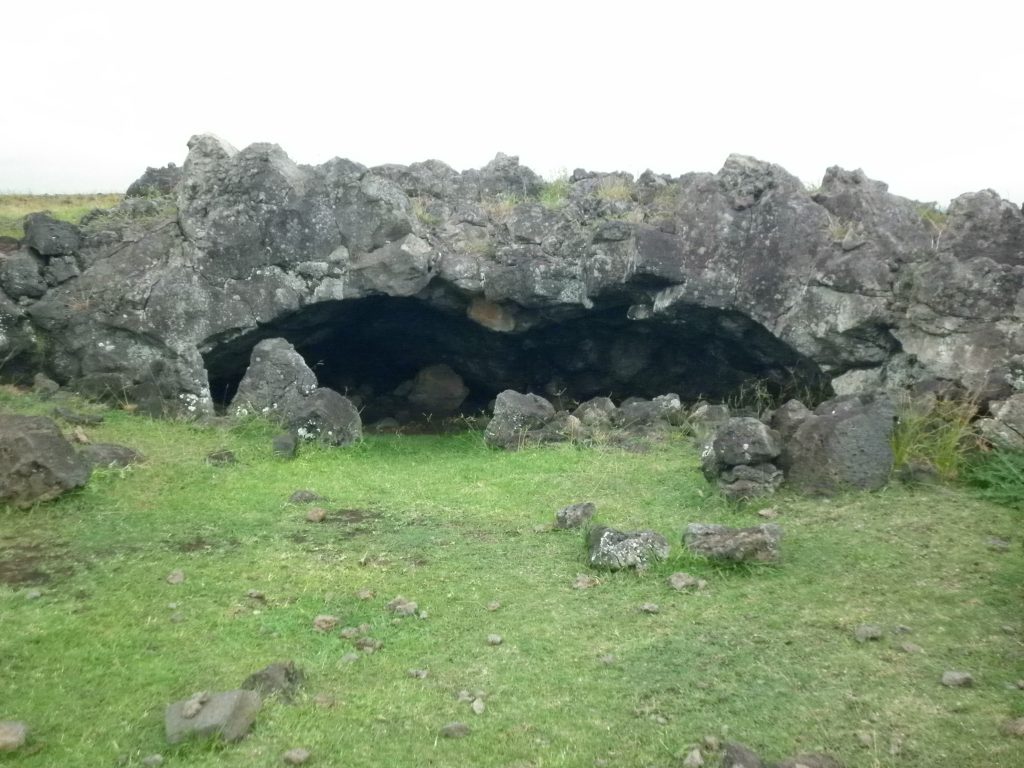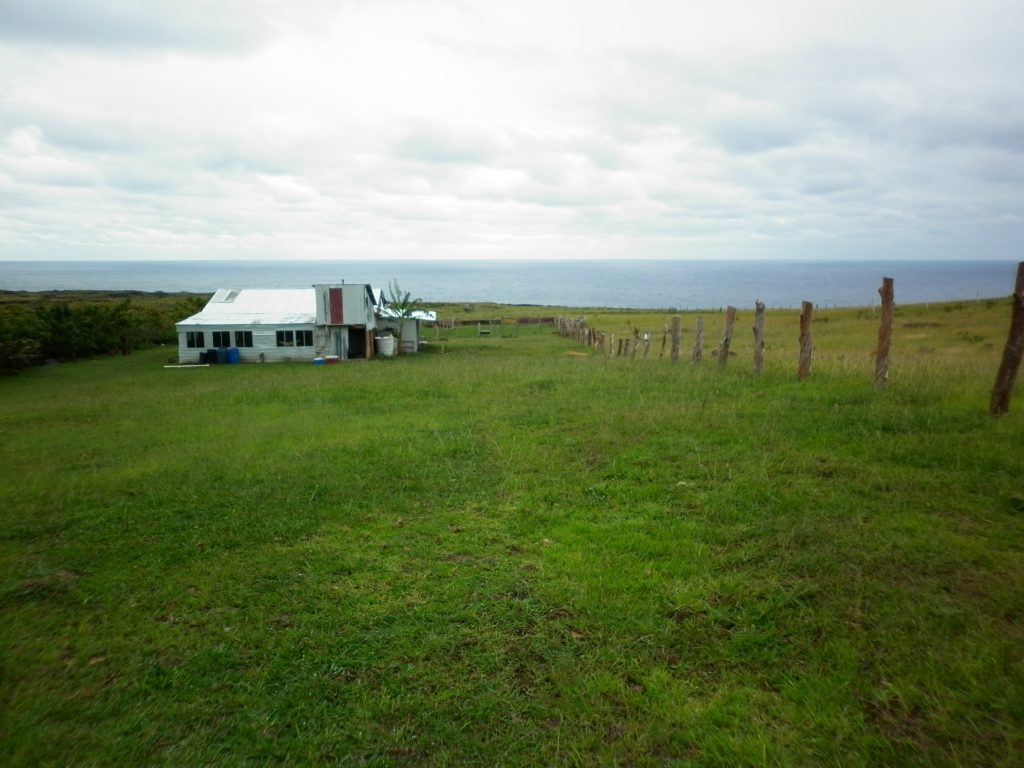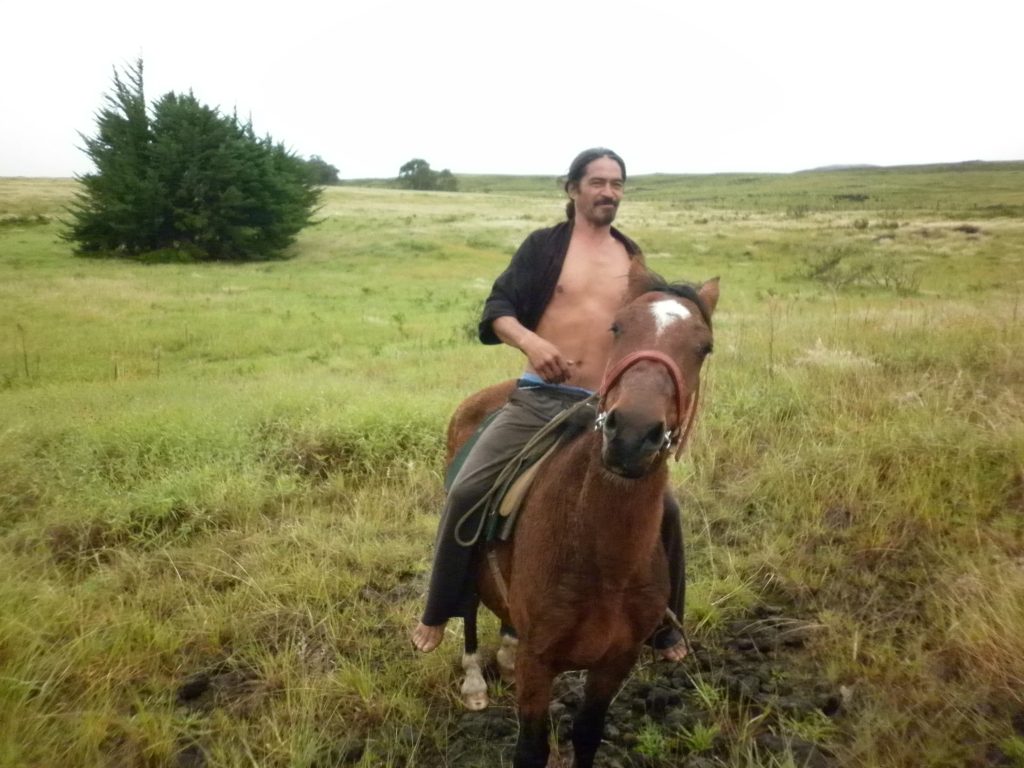I left Puerto Natales this morning at 7:30 for the roughly 5.5 hour bus ride to El Calafate, Argentina. The ride was very scenic with open grassland. At one point, I could even see the Torres del Paine in the distance, where I had spent 6 days and 5 nights having my soul blown away by the natural beauty that the Parque Nacional Torres del Paine had to offer. (I’ll post an article on that soon enough.)
My first impression of Argentina is that I’m starting all over again with learning a new country. For starters, the money is different. While considering options to go visit the Perrito Moreno Glacier, I kept calculating Argentinian pesos into U.S. dollars. Also, since I don’t have a guidebook to Argentina, I’m slowly discovering what the Argentinian Patagonia has to offer through research on the internet- Wikitravel seems to do the trick.
My second impression of Argentina is that I really love starting anew! There’s so much to learn just from being in a new town or in a new country. Impressions form instantaneously. El Calafate in the low season is still expensive explained by the laws of supply and demand. Based on the cost of my accommodations and food, Argentina seems to be slightly cheaper than Chile.
I’ve been traveling with two French couples and an Australian guy, David, all of whom were on the same bus to Parque Nacional Torres del Paine in Chile. They’re a great group and I’ve taken it upon myself to learn some French while I’m with the French. I spent my entire time in the park with David since we were hiking on the same itinerary provided to him by the Erratic Rock hostel in Puerto Natales. David’s really down-to-earth and as adventurous as I am. It was great to have him around to share what an amazing experience Torres del Paine was.
I’m still trying to mentally and spiritually process my experience in Torres del Paine. At some point soon, I’ll post the blog report about it. Stay tuned.
View Puerto Natales, Chile to El Calafate, Argentina in a larger map
The Navimag ferry to the Patagonia
It was Monday, May 23, 2011. Kayla, Javiera, Marnoch and I were all up early to catch buses and part ways after traveling together for the last 4 days. Javiera left the Nuevo Mundo hostel the earliest to catch her bus at 8:35 am to Puerto Montt to be in time for her afternoon flight back to Santiago. Kayla, Marnoch and I left for the bus station at 9 am. Marnoch and I boarded the 9:40 am bus to Puerto Montt, saying our last goodbyes to Kayla who would later leave by bus to Castro where she would spend more time exploring Isla Grande de Chiloe.
Having danced the night away, I slept the entire way back to Puerto Montt. Once Marnoch and I got there, we picked up the backpacking equipment that we left a few days earlier at the Casa Perla hostal, shook hands and then said our goodbyes. Marnoch would proceed north to Bariloche, while I would go south via the Navimag ferry to Puerto Natales in the Patagonia.

I boarded the Navimag at 4:30 am. Since it was low season, there was barely anyone on board. It was four Argentinian men, two British men, one British woman, and roughly 8 Chilenos. I was beginning to get worried that I would be bored out of my mind with hardly anyone to talk to for the 4-day/3-night voyage to the Patagonia. I wrote a few e-mails and downloaded a book on my Kindle just before the ferry set sail from Puerto Montt.
My highlights from the trip are as follows:
- Making friends with the Argentinian film crew. I definitely enjoyed their conversation. Thank you, Gustavo M. L., Guillermo K., Gustavo J., and Vicente P. Since I was alone, they were the first to invite me to sit with them during dinner and I ended up spending more time with them than with any of the other passengers. They shared one of their Argentinian customs with me, the drinking of mate. It was also very interesting to see them at work on their documentary about Domingo Sarmiento, an historical Argentinian educator.
- Making friends with the Brits, Darren, Deb, and Mark. It always nice to be able to speak English at a normal pace.
- The food. The Navimag served delicious steak, chicken, and fish. I usually went up for seconds. Gustavo joked that he could invite me to his house in Buenos Aires, but I wouldn’t be invited to dinner because I’d eat all his food.
- The scenery. As we ventured through the channels between the uninhabited islands, it felt like we were moving further and further from civilization – like in Joseph Conrad’s Heart of Darkness or Stanley Kubrick’s Apocalypse Now. The gray, winter sky added further to the eerie feeling. The islands were truly beautiful though. Some had waterfalls. Others had snow on their mountain tops.
- The wildlife. We could see penguins and seals.
- The rainbow near the shipwreck. Very pretty.
The not-so-great parts of the voyage were:
- The showers had neither hot, nor cold water. It was good enough for me, but I don’t think most passengers were pleased with it.
- Motion sickness. As the ferry moved out into the ocean, we could really feel the waves. I thought it was fun at first, like a roller coaster, but then it later felt like the world was spinning in my head the way it does after drinking too much. I felt better as soon as they crew played the evening movie, Apocalypto. I suppose it’s because I was visually fixated on something stationary, just as staring at the horizon is supposed to help alleviate seasickness.
Overall, I thought the ferry was very relaxing and my accommodations were comfortable. I finished my book, was entertained by movies that the crew played, I loved the food, and I enjoyed the company of the Argentinians and the Brits.
Killing time in Chiloe
When I first arrived in Puerto Mont on the morning of May 18, 2011, via an overnight bus from Santiago, I was the only staying at Casa Perla, a small hostel located near the bus station. An e-mail from the Navimag company later that afternoon said that due to poor weather, my Friday departure date on the ferry to Puerto Natales in the Patagonia would be delayed until the following Monday.
That gave me extra time to explore the nearby island of Chiloe. The weather was cold and rainy and I wasn’t really all that motivated to make plans to do anything. Not too long after I had arrived, a Scot named Marnoch showed up. It was good to have company and someone to talk to. Later that night, a Chilena named Santiago named Javiera also arrived at the hostel. Javiera was on vacation for a few days and had plans to also visit Chiloe.
The following day, Javiera, Marnoch, and I went day-hiking in Parque Vicente Perez Rosales. It rained the entire time, but we had made a pact the night before to go hiking regardless of what the weather was doing. After our hike, we went to Puerto Varas and hung out a little bit before going back to Puerto Mont.
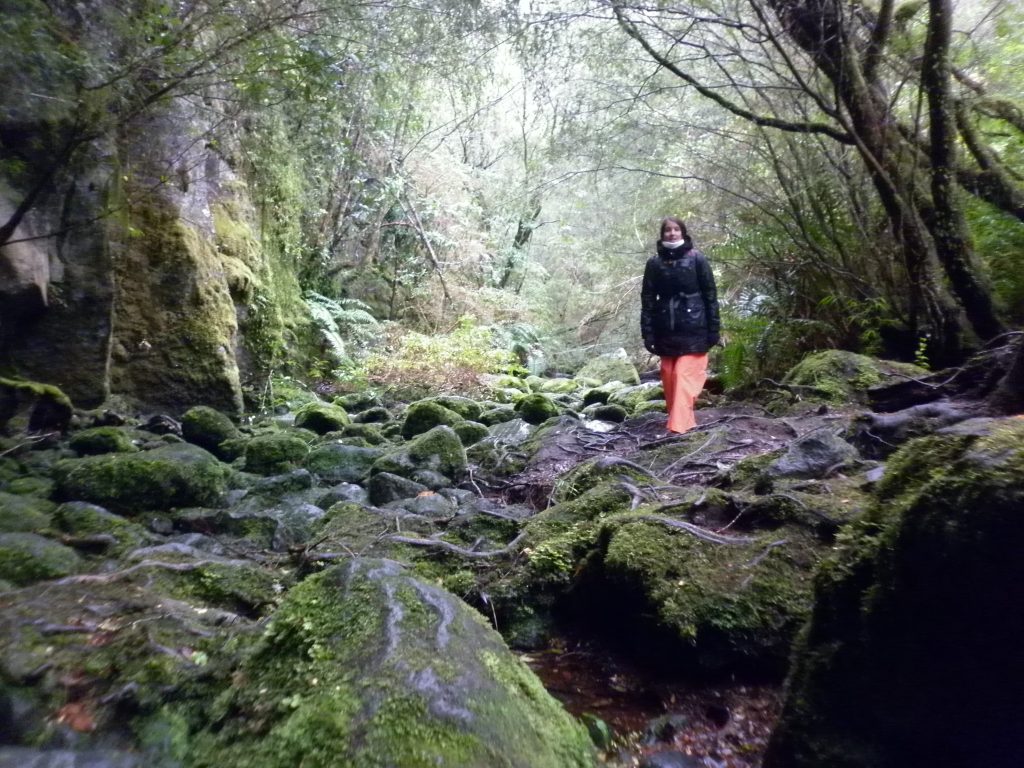
Javiera in Parque Vicente Perez Rosales (but I think it looks more like JRR Tolkien's Middle Earth or Narnia!)
Back at Puerto Mont, Kayla, an American showed up. She was living in Buenos Aires, Argentina, but was traveling through Chile at the moment. Her plans were to visit Chiloe over the next few days, too. So now our small ad hoc band of travelers had increased by one more! The next day we took the ferry to Chiloe and stayed at a lovely hostel called Nuevo Mundo in Ancud.
Chiloe is famous for its mythology, its UNESCO-designated wooden churches, its houses on stilts, called palafitas, and its delicious seafood.
I found that the cities that we visited, Ancud, Castro, Achao were all very picturesque, small, sleepy towns with a wooden church. My favorite part was going out for drinks and dancing on the last night that we were there on May 21, 2011.
We couldn’t find a place that was open initially. We wandered the streets in Castro until we heard the sound of music. We followed that sound and found a karaoke bar full of Chilenos. The fun thing about Spanish karaoke is that you can fool people into thinking that you really know Spanish as long as you know how to read. I always have a blast when I read Spanish karaoke.
Our group ordered a tall cylinder of beer and sang to our hearts’ content. A large group of Chilenos, about 6 girls and 3 guys, invited us to sit with them and so we obliged. Later, Kayla and I went dancing with them and didn’t get home until late. Earlier, we had decided against going to that club because we heard there were fights there, but we felt safe since we were with Chileno friends. I’m glad we went because that was one of the highlights of my visit to Chiloe.
I boarded the Navimag ferry in Puerto Mont the following afternoon, May 23, 2011, for the 4-day voyage to Puerto Natales, my first port of call in the famed Patagonia.
(The other highlight was not getting sick from the mystery shellfish soup that I had bought in the market and cooked at the hostel. It was good and cheap, and had I known about its existence earlier, I probably would’ve subsisted on it during the entire time I was there.)
View Larger Map
I don't know how to ride a horse, but I can fake it pretty well.
It was May 13, 2011. I was still on Easter Island, Chile. I had arranged to rent a horse from Pepe, the local Rapa Nui who I befriend two days earlier. Rather than go through a formal tour operator, I thought I’d be wise to side-step the middle-man and go directly to a supplier of horses. By arranging it informally, I know I could get exactly what I wanted: a horse and the freedom to explore the island unsupervised. The deal I got from Pepe was decent, $40 USD for an entire day unsupervised. For the same price, you can get 3-4 hours on a guided tour up Maunga Terevaka, the highest point on Easter Island.
I had asked for Pepe to come pick me up at the campground at 9 am; he showed up sometime around 9:45 and 10:00 am. I was hoping he’d come earlier because I knew I had a lot of ground to cover during the day, but the cultural concept of time is drastically different in South America than in the U.S. As a foreigner, it’s important to accept this fact lest one be constantly frustrated with every minute past an expected time.
We rode via motorbike to Pepe’s farm. While there, Pepe and a buddy, corralled one of the horses so they could put a saddle on it. Pepe assured me that this was a strong horse that could carry me up Maunga Terevaka, the highest point on Easter Island at 1664.73 ft. Good, I thought. I’m going to ride the hell out of this horse and see everything on Easter Island.
As soon as I mounted Pingo and headed towards the road, Pingo started on a fast trot. This horse was a lot more robust than the docile horse I had ridden a week and a half earlier on a tour with my class at Las Cascadas Resort, outside of Santiago. Once we got to the rode, Pingo took off on a runaway gallop. My right foot slipped out of the stirrup and I struggled to gain control of Pingo as we careened off into a field next to the road. I thought to myself, If I fall off of this horse, I’m going to be in BIG trouble.
I pulled the reins with all my might to get Pingo to stop. Finally, I got him under control. I put my foot back into the stirrup. As soon as I loosened the reins, he started galloping again! It seemed the entire way leading up to our ascent up Maunga Terevaka was a power struggle! “Slow down!,” I yelled each time he tried to runaway beneath me. At one point, I had even considered returning Pingo to exchange him for a slower, more docile horse.
The way up Maunga Terevaka is a lot more complicated than it looks. Although much of the island is rocky grassland, it’s crisscrossed with private fences. Luckily, I encountered a Rapa Nui man named Chino who showed me the way. We trotted together for a little bit before parting ways so that I could begin my ascent. As we trotted, he could see how robust Pingo was and complemented on how fine a horse Pingo was.
The steep climb up Maunga Terevaka was a welcome respite from the runaway galloping that Pingo was so inclined to do. As we climbed, I could see the great, blue ocean below, the grassy plain of the island, and Easter Island’s only town, Hanga Roa. The sky was clear and sunny; the breeze was comfortable. How lucky I felt to be there at that moment – and more especially so as we finally made it to the top of Maunga Terevaka.
The top of Maunga Terevaka gave me a 360 degree panorama of the largest terrain features of Easter Island: the Poike Peninsula, Hanga Roa, and Rano Kau volcano to the south. There isn’t much to the island as it is only 15.3 miles long and 7.6 miles wide.
I descended the northeast side of the mountain towards Anakena. We walked on the beach, admiring the bright blue color of the water and the white sands, until we got yelled at by one of the staff there. I had read the sign that said “No recreational vehicles allowed,” and I thought nothing of it because I didn’t consider a horse to be a vehicle in the same sense as an automobile or a motorbike. That was fun while it lasted. Besides, I was getting a little bit frustrated with Pingo because, for some odd reason, he kept wanting to turn left. A crazy horse he was!
We stopped to talk pictures at the moai before galloping away, following the road that led across the Poike Peninsula. At this point, both horse and rider interests were aligned with one another. We encountered buses and cars full of tourists heading in the opposite direction. We galloped even faster as we approached them. We were quite the spectacle!
We made our way to Ahu Tongariki, the site that had 15 moai. As I dismounted to tie Pingo up to a post near the entrance, I heard a French woman ask her husband if I was also a tourist or a local Rapa Nui. She undoubtedly figured it out as I walked down to the moai to take pictures.
Because of the approaching sunset, Pingo and I had to skip the quarry, which is one of the highlights of the island where the Rapa Nui would construct the moai. We tried to gallop/trot all the way back to Hanga Roa. Night came. By the end of the day, both Pingo and I, were thoroughly exhausted. He didn’t want to run anymore, and I no longer wanted to be in the saddle. I had to dismount and pull him behind me.
We finally made it back to the campsite at Mihinoa where I was staying. We both drank copious amounts of water. Back at Anakena, I refused to pay $3 for a 500 mL bottle of water so I was very parched. Pepe came for the horse.
I made dinner and fell asleep on a bench in the kitchen. I was sore for days from all that cabalgata, but it was well worth it. It would’ve been nice to have someone there to whom I could express the incredible sensation of being on a horse on top of Easter Island, but that comes with the territory when traveling solo.
View Larger Map
Life and lemons on Rapa Nui.
Sometimes things work out even better when a plan falls apart. There’s always opportunity. Case in point: it was last Tuesday, May 10, 2011, when I started off in the morning for a day-long hike from my campsite at Mihinoa on the south side of Easter Island all the way to Anakena beach in the north. My plan was to hike out there, enjoy the beach, and hitch-hike back.
The early part of the hike was beautiful. I saw a couple of Rapa Nui statues, called moai. Apart from the herds of horses next to the trail backdropped by the deep blue ocean, it was a lonely hike.
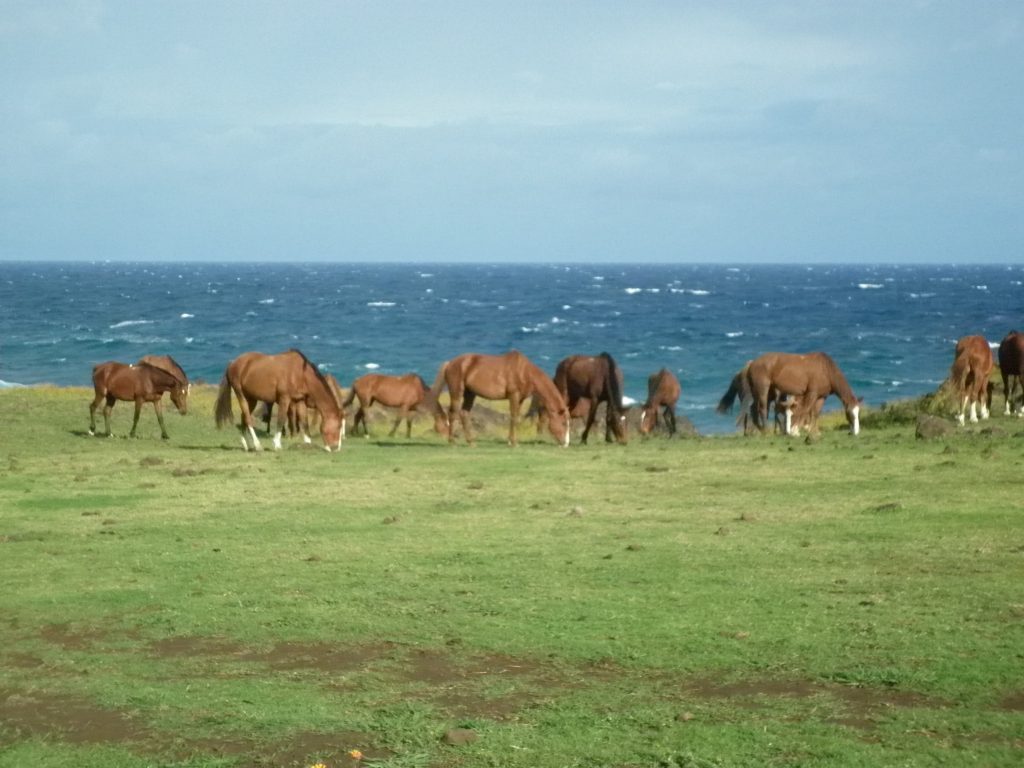
I stopped to explore a small lava tube that had created a cave. There was a brown sign that explained the historical and cultural significance of the lava tube. The early Rapa Nui people used to hide in the caves during times of war. I took my small flashlight and walked through one of them emerging through a small opening approximately 30 feet from the entrance. Cool enough, I thought. Time to move on.
At one point, I had to stop and nurse a hot spot on my foot that was developing from the friction in my boot. I took my water bottle, tore off a piece of duct tape that I had wound around the water bottle, and applied it on my foot. When I looked out onto the ocean, I could see a storm cloud approaching, a vertical, gray shadow of torrential rain connecting the ocean with the cloud.
I saw that I was near a farmhouse so I made my way there to ask its inhabitants if I could take shelter there rather than press on with my hike and get drenched. I could’ve also taken shelter in a lava tube- Hey, if it’s good enough for the early Rapa Nui, it’s good enough for me!
I had no idea what to expect at the farmhouse and decided to give it a try. As I walked to it, I saw a red truck parked in the yard. Surely someone was home. I came to the house first and saw that it was empty. I then walked to the truck and could hear people working in the nearby shed. At the shed, I called out, “Hola?”
A barefooted man in torn jeans came out. I told him I was hiking and saw that the rain was coming. I asked if I could stay with them to wait for the rain to pass. He said that was fine and that I could just go and wait in the house. “Gracias,” I said. I asked him what his name was, and he said, “Pepe.”
I went to Pepe’s house unaccompanied. It was clearly a bachelor pad from the looks of it. But for protection from the rain, it was more than sufficient. I sat down on the living room couch and took out my Kindle to read and pass the time.
Pepe came in after about 15 or 20 minutes. He was with his cousin, Jose, who wore a blue bandanna on his head like a Los Angeles gang member. The rain came down in a torrent. I could hear every drop since the roof was made out of thin corrugated metal.
It was about 2 pm when the sky cleared up. They asked me if I was still going to Anakena, and I said probably. They told me they didn’t think I had enough time to get there unless I planned on running there. Now I’m not sure how the conversation continued after that because my spanish comprehension is still lacking, but I ended up going fishing with them for the afternoon.
We all hopped in the Pepe’s red truck and drove on some Rapa Nui backroads that were barely roads. Some of the land was fenced and gated in. Jose had to get out to open gates a couple of times. As we drove, we came across some other Rapa Nui locals who had their car stuck in the mud. Pepe drove up to them and we waited while someone brought a rope to tow the car out of the mud.
A Rapa Nui guy galloped up on a horse with a rope. The two vehicles were attached and the car was free moments later. We drove on.
The landscape that we were on was marvelous. We were driving on a bare hill strewn with large lava rocks. There were very few trees so the view of the ocean was unobstructed. Except for me and my new-found Rapa Nui friends, it felt like were the only people on the island. We drove by several ahu, which were piles of stone that Pepe and Jose’s traditional ancestors had built for burial purposes or to erect the large statues, or moai, that are so unique to the island. As we drove to Pepe and Jose’s secret fishing spot, I was very much aware of the fact that seeing this part of Rapa Nui in this way is something 99.9% of tourists don’t have the opportunity to do.
We finally arrived at the secret fishing spot. Waves smashed onto the rocks violently, sending water into the air with each thunderous crash. The overwhelming amount of activity was reminiscent of a grand finale of fireworks on the Fourth of July.
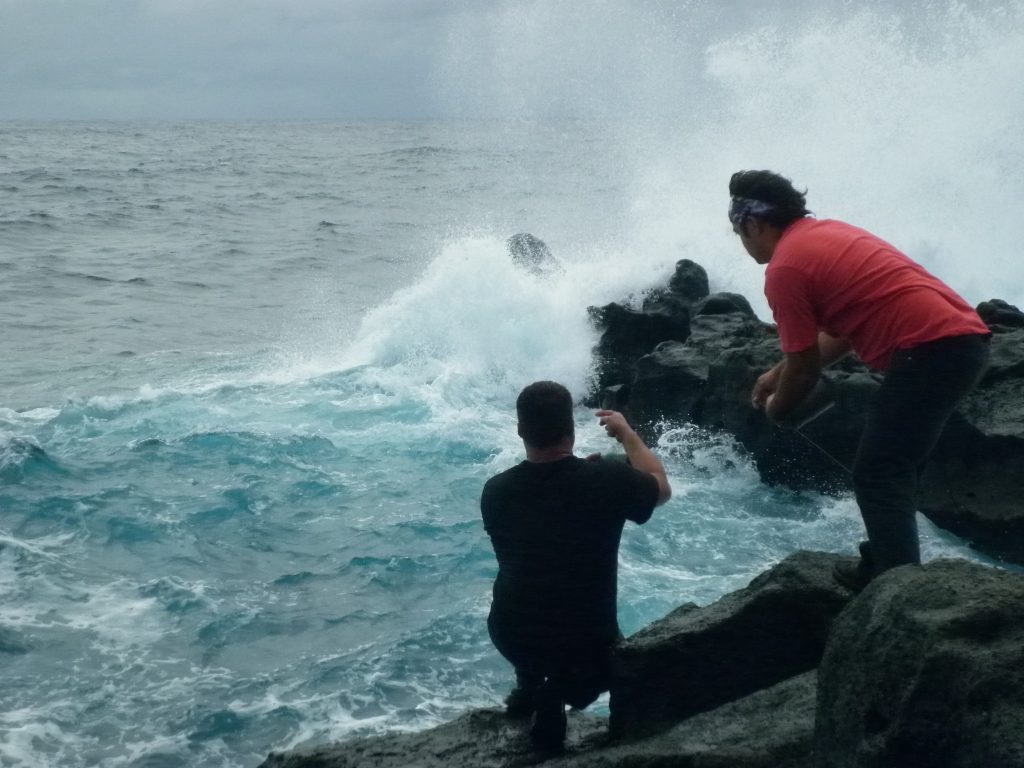
My friends bit off pieces of raw chicken, baited their hooks, and ventured far out onto the rocks with their hand reels, which amounted to nothing more than pieces of PVC pipe with fishing line wrapped around them. I admit that I was reluctant to follow them onto the rocks. What if I lost my footing, slipped and fell into the ocean? I had to watch them pass back and forth a couple of times before I followed them. Once I did, it felt perfectly safe.
I watched as Pepe and Jose whirled their lines in the air before casting them. Jose proceeded to catch five fish, placing them into shallow tidal pools next to his feet. We ended up calling it quits after five fish because Jose lost his hook while trying to snag a backpack that was floating in the water.
We climbed back up the rocks and hiked up the hill to the truck to drive back home. There we cooked up the fish and ate it with rice. Our appetizer was chicken and crab soup, the chicken having been the leftover bait that wasn’t used for the fish. It was all delicious, my first real substantial meal on Easter Island. Prior to that, I’d been cooking my own food which was nothing compared to what they cooked.
After dinner, Pepe and Jose drove me back to my campsite. I never made it to Anakena, but I had a great time spending the afternoon with Pepe and Jose. I asked Pepe if he had any friends who I could rent a horse from. He said he had some and we agreed to do business future. It was a great day. I made new friends, took care of business, and got to experience a day in the life of two Rapa Nui locals. As the saying goes, “When life throws you lemons, make lemonade.” Had that rainstorm not come, I wouldn’t have had such an awesome experience with Pepe and Jose.
"You eat sea urchins the same way you that you kiss a woman."
The Rapa Nui women who showed me how to eat sea urchins on Easter Island, Chile.
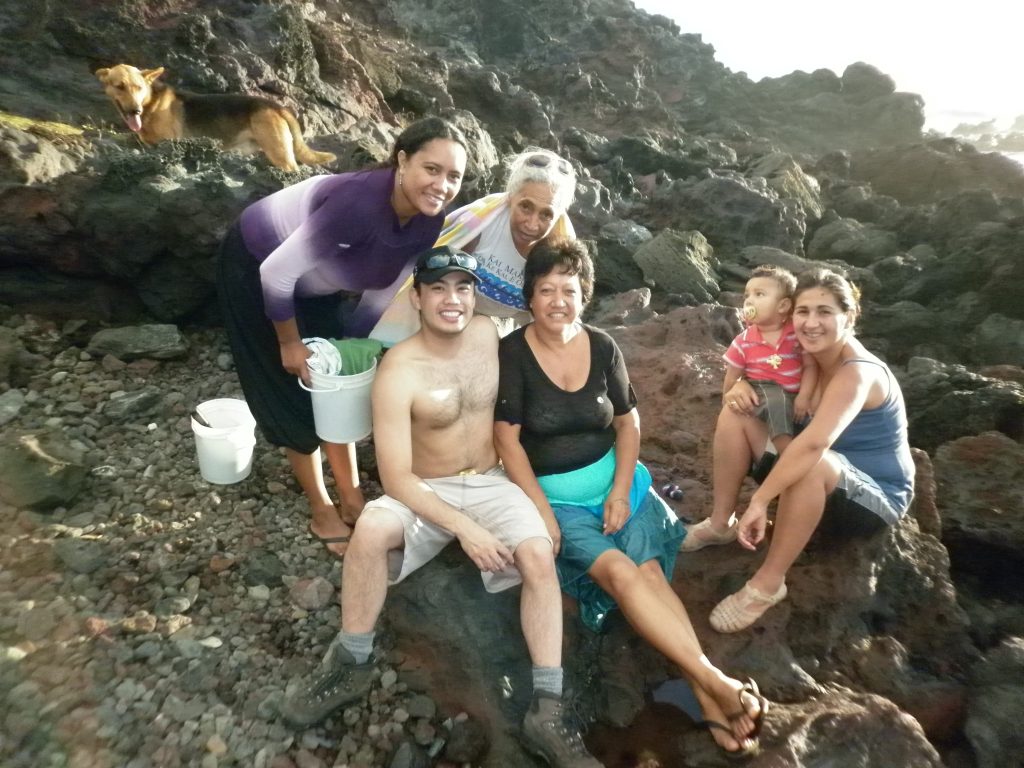
Casie and one of the Rapa Nui women.

I arrived on Easter Island on Sunday, May 8th. I met Casie, a girl from California who was staying at the same place that I was, and we started walking from our campsite at Mihinoa towards the moai statues that lie just north of the harbor at Hanga Roa.
We were walking along the sharp, lava rocks that lined the coast line when we encountered four Rapa Nui women and a 1-year old baby scouring the tide pools. Curiosity, as always, got the best of me and so I went up to them to ask what they were doing.
They said they were picking sea urchins. Of course, I didnt understand them because I dont yet speak Spanish well enough, but I could tell just by looking at what they were collecting in their white, plastic bucket.
I watched as they placed one of the dark, purple sea urchins against the rock and broke it in half with a screwdriver. Then they would put the sea urchin to their mouths and suck out the orange and black slime that was inside of it.
They offered me to try it, and so I did. I was reluctant at first because of the sharp spines on the sea urchins. Then one of the ladies told me in Spanish that I was supposed to eat the sea urchin like I kiss a woman. (Thank goodness Casie was there to translate because I had no idea what the Rapa Nui woman said!) “¿Con mucho cariño?,” I asked. [meaning “with lots of affection?”]
“Muuah. Muuah!” I pretended like I was kissing the sea urchin affectionately. They laughed. Then with all seriousness, I puckered up and sucked the orange and black slime out of the sea urchin. Tasty it was. Now I know that you eat sea urchins the same way that you kiss a woman- though I won´t be doing it with as much “cariño.”
Got my one-way ticket!
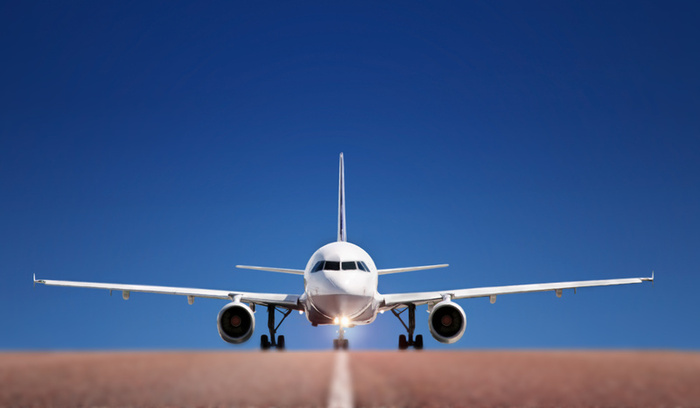
Back in December, I bought a one-way ticket to Santiago, Chile. There’s nothing like that moment of truth when you’re one mouse-click away from purchasing that international flight. You think to yourself, “Maybe I should reconsider…”
But then you realize you have already done that dozens of times before. You’ve laid awake at night thinking about it. You’ve weighed the pros and cons over and over again to the point of madness. You dwell on it constantly throughout the day, consumed by the idea. Your mind’s a whirl with countless possibilities. It’s your imagination on steroids.
You buy the ticket. It was the only way to put an end to the restlessness. At this point, you’re committed and there’s no turning back.

